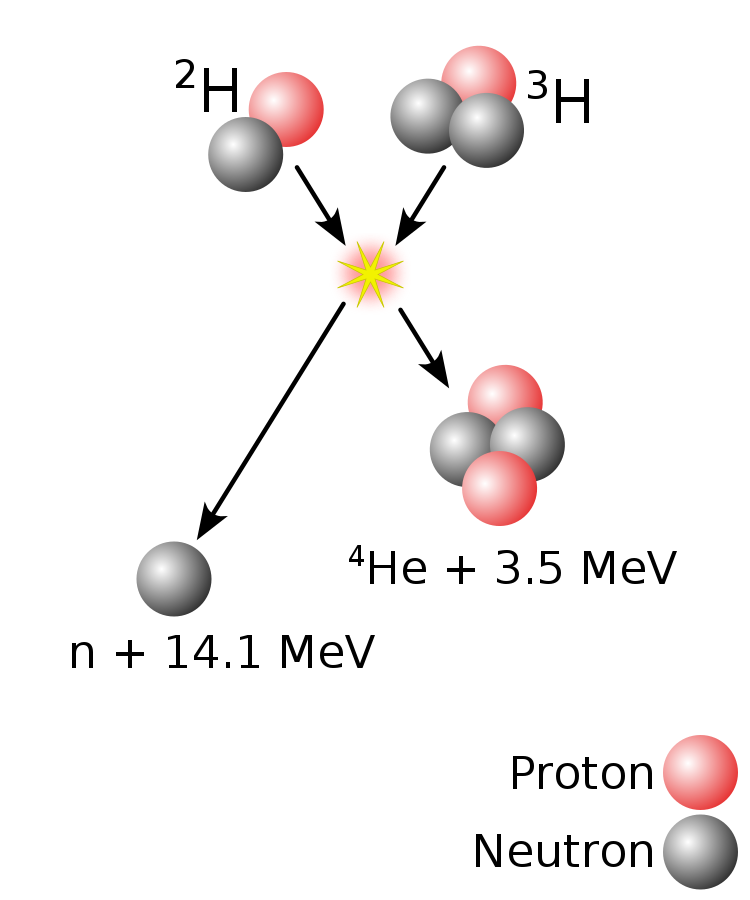What is Fusion?
Fusion is the process that powers the sun. When we squeeze ("fuse") together atoms of "light elements" under extreme temperatures and pressures, they form a new type of atomic nucleus and in the process release a small chunk of energy into the surroundings. "Light elements" are atoms of materials with less atomic mass than an atom of iron, including hydrogen (which powers the Sun), deuterium and tritium (used in STEP).
Albert Einstein's greatest equation - E = ∆mc2 is the means by which fusion generates energy. When the two source atoms fuse together, the weight of the new single atom is less than the combined weight of the two source atoms. This difference in mass (∆m) is lost as energy (E). This energy is calculated by multiplying ∆m by the speed of light multiplied by itself (c2 where c = 299,792,458 meters per second).
As the value of the speed of light squared is so large, a tiny amount of mass lost results in a very large amount of energy being released. This is how a fusion reactor produces energy.

Power from Fusion
The process of fusion in the Sun is less efficient compared to some other methods we can use, such as the fusion reaction between deuterium (heavy water easily sourced from seawater) and tritium (which can be created from lithium, readily available on Earth). The D+T process is often used in fusion technology to produce energy, and this would be the process used by a fusion reactor.
Is Fusion worth the effort?
The energy released by fusion is significant - 1kg of fusion fuel - comprising of deuterium generated from water and a few grams of tritium generated from lithium, produces the same amount of energy as approximately 10,000,000 kg of coal. Or to put it another way, the electricity generated from the deuterium in half a bathtub of water and a laptop battery can generate enough electricity required by a human over their entire lifetime.

Why do we need fusion if we have lots of renewable power?
Climate change and energy shortages are a global crisis.
Whilst the UK is fortunate to have access to a large renewable resource (mainly wind), other parts of the world are not so fortunate. In 2050 it is expected that even on our current trajectory to globally reduce carbon emissions, 50% of the worlds energy will still come from fossil fuels.
Unless humans continue to work hard to develop new low carbon forms of energy production, our global crisis will continue for many decades and centuries to come, putting everyone at risk of the impacts of climate change.
Whilst fusion will not be able to solve all these problems immediately, fusion power would be able to assist the race to net zero carbon beyond 2050 into the next century and provide a valuable energy resource alongside renewables and other zero carbon energy sources.
Will this solve the Climate Emergency?
The climate emergency is an immediate need to reduce carbon emissions over the coming decades. However with continued decarbonisation of transport (electric vehicles) and heat (moving from methane gas to electrically powered heat pumps and electrically produced green hydrogen), we will need to continue to find solutions to our ever increasing energy demands.
Developing fusion energy will allow us to think ahead to 2050 and get prepared to solve our energy needs in the second half of the 21st century. Developing fusion into a mature technology will still take a number of decades, but now is the time to get involved and help support the global fusion race. UK fusion industry activities such as the UKAEA STEP programme and other UK fusion companies will also help plant the UK's flag in the ground as a leading player in the next chapter of the global energy story.
What has been achieved so far?
Nuclear fusion has been studied for over 100 years, however we are now reaching the final stages of development, and as large experiments such as ITER solve some of the final key challenges, the technology will reach a stage of maturity where it will be suitable for use in an industrial power generation plant such as the UKAEA STEP prototype. Fusion follows similar rates of development to other industries such as computer technology which uses Moore's Law which states technology advancements double every 2 years. Fusion technology advancements are doubling every 1.8 years - so is ahead of Moore's Law!
The UK has always been at the forefront of fusion advancements and with the UK Government and UKAEA STEP programme we hope to once again lead the world in the development of new fusion technology to help solve our global energy challenges.
